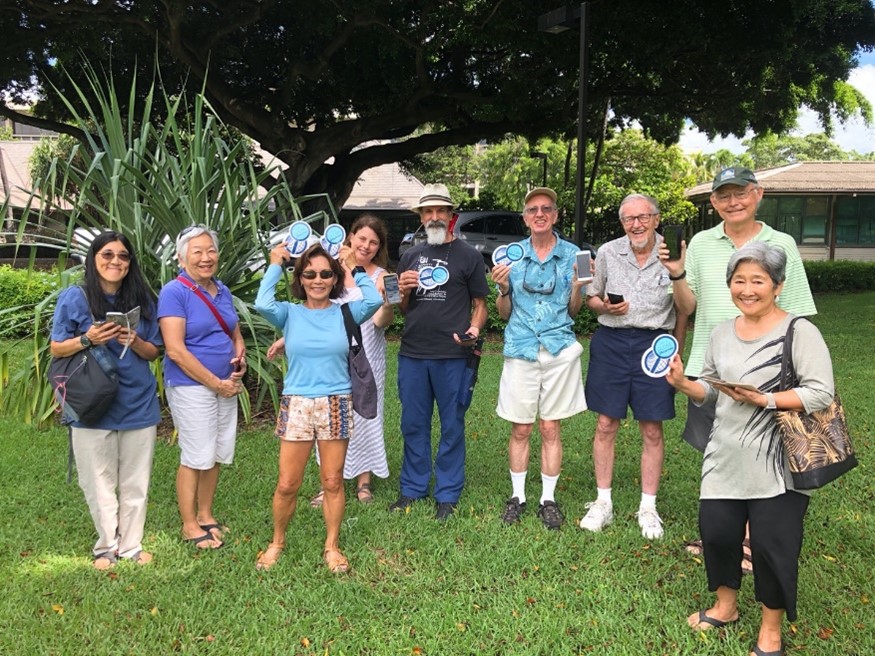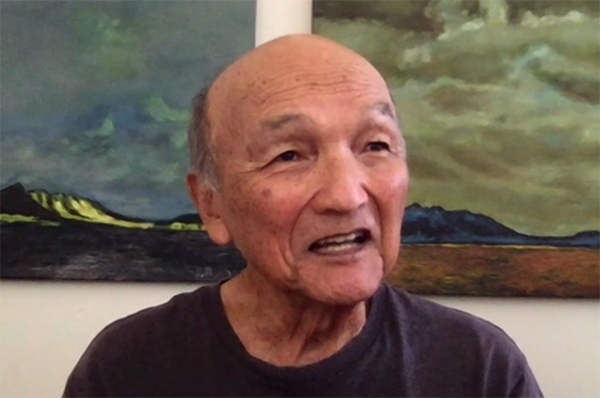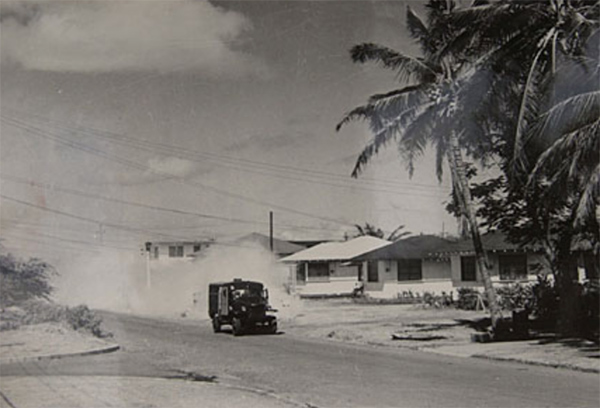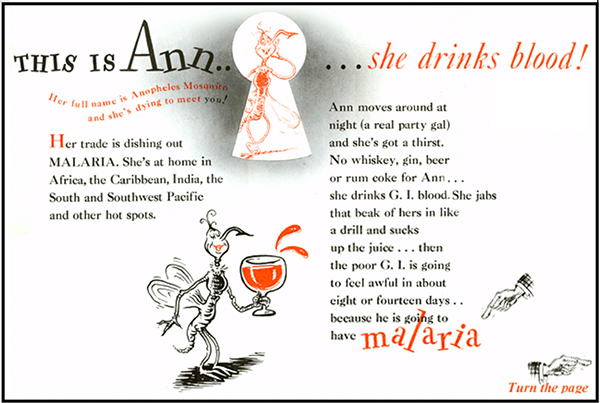News - GLOBE Observer
New Meets Old -- Mosquito Habitat Mappers
Finding and eliminating mosquito breeding sites as a way to reduce vector-borne disease has a long and interesting history.
For many of us in the U.S., it is believed that mosquito control is a problem for our municipal governments to address.
However, around the time of World War II, behaviors and attitudes were quite different. In 1941, before the U.S. was actively engaged in combat in the South Pacific, mosquito vector-borne disease was a serious problem for the troops stationed there. Two of the many control measures used by the military to help eliminate the mosquitos that transmitted dengue included putting screens in windows and aerial spraying of oil on standing water.
It was during last year’s GLOBE Observer workshop at the Osher Lifelong Learning Institute (OLLI) at the University of Hawaii at Manoa, we learned from one of our participants that during wartime, even young children were assigned tasks to control mosquitoes and combat disease.

Born in 1931, Dr. Herb Kobayashi, an OLLI member, remembers that as a child he and his classmates were mobilized to play an active role in reducing the threat of dengue and other mosquito-borne tropical diseases. Several afternoons a month, Dr. Kobayashi and his classmates were dismissed from school early to go outside and do important health detective work – to find the stagnant water breeding sites of mosquitoes hidden all over the city. Once the watery breeding sites were located, the kids were instructed to dump out the water. By eliminating their aqueous habitat, immature mosquitoes could not grow into biting adults capable of transmitting disease.

According to Dr. Kobayashi, mosquito mitigation activities were reserved for the younger students because their older and stronger classmates were recruited to work on the pineapple farms. Their labor was needed to replace that of the adults who went to war. “During the WWII,” Dr. Kobayashi reminisces, “going to class wasn’t nearly as high a priority as contributing to the war effort.”
Source-reduction is the technical term for dumping standing water found in containers. It is now regaining its importance as an effective way to control mosquito populations. Toward the end of the war, the broad-spectrum pesticide, Dichloro Diphenyl Trichloroethane (DDT), became widely available and was extensively used in the Hawaiian Islands to eradicate mosquitoes and control vector-borne disease. Effective and inexpensive, DDT eliminated the need for citizens to regularly monitor and dump water containers, and the practice was deemed no longer necessary by public health agencies.

However, DDT pesticides are highly toxic, not just to mosquitoes but also to a broad range of organisms. The chemical accumulated in food chains and caused ecosystem disturbances all over the world. Fortunately, DDT was banned in many countries by the 1970s. Now there are safer pesticides available to control mosquito populations. These pesticides are applied as part of an integrated pest-management program.
“Integrated Pest Management (IPM) is a sustainable, science-based, decision-making process that combines biological, cultural, physical and chemical tools to identify, manage and reduce risk from pests and pest management tools and strategies in a way that minimizes overall economic, health and environmental risks” according to A National Road Map for Integrated Pest Management published by the USDA in 2018.
Source reduction is now reemerging as an important community practice to control mosquito populations and is one of the most effective ways to reduce populations of disease-transmitting container-breeding mosquitoes – such as the Asian tiger mosquito (Aedes albopicutus) and the yellow fever mosquito (Aedes aegypti), two dangerous invasive species now found worldwide.
The GLOBE Observer Mosquito Habitat Mapper tool brings the schoolboy efforts of Dr. Kobayashi into the 21st century. It not only supports the dumping and removal of mosquito breeding sites by citizen scientists, but it also reports where and when mosquito habitats are found. These data can support coordinated local mosquito control efforts taking place at the municipal level. The data are also useful for scientists who are studying when and where mosquitoes are found on the landscape, as these data are used by researchers who create models that predict future outbreaks of vector borne disease. And importantly, every time a citizen scientist removes a breeding site from use, fewer mosquitoes grow up, bite, and potentially transmit a serious disease. Mosquito Habitat Mappers are agents of change, improving the health and well-being in their communities.
Fun Fact:
Recognize this artist? Before he became famous as Dr. Seuss, the author of popular children’s books, Theodore Geisel served as a captain in the U.S. Army during World War II. He applied his talents in the creation of a malaria awareness pamphlet for GIs, “This is Ann…she drinks blood!” (Ann gets her name from Anopheles, the genus of mosquitoes that transmits the pathogen that causes malaria in humans).

You can make a citizen science contribution today. Add your mosquito habitat observation to the more than 26,000 observations uploaded so far to the GLOBE database, by downloading the GLOBE Observer app to your mobile device. You can learn more about The GLOBE Program and the Mission Mosquito campaign by visiting the this website. To learn more about mosquito-vector borne disease, check out Beyond the Bite: GLOBE Mission Mosquito Disease Guide.
About the Author: Dr. Russanne Low is a senior scientist at the Institute for Global Environmental Strategies, Arlington VA, USA. She serves as Science Lead for the GLOBE Observer Mosquito Habitat Mapper tool and the GLOBE Mission Mosquito Campaign.
References:
Beadle, C. and Hoffman, S. L. (1993) History of Malaria in the United States Naval Forces at War: World War 1 through the Vietnam Conflict. Clinical Infectious Diseases 16(2): 320-329. Retrieved from: https://www.jstor.org/stable/4456917.
Hurley, T. (2001). Outbreak renews debate over DDT. Honolulu Advertiser. October 12. Accessed at: http://the.honoluluadvertiser.com/article/2001/Oct/12/ln/ln02a.html.
Doucleff, M. (2012). Dr. Seuss on Malaria: ‘This is Ann…She Drinks Blood.” NPR News, August 20, 2012. Accessed at: https://www.npr.org/sections/health-shots/2012/08/20/159382005/dr-seuss-on-malaria-this-is-ann-she-drinks-blood
A National Road Map for Integrated Pest Management (2018). FRS, USDA. Accessed at: https://www.ars.usda.gov/ARSUserFiles/OPMP/IPM%20Road%20Map%20FINAL.pdf
Comments
View more GLOBE Observer news here.








